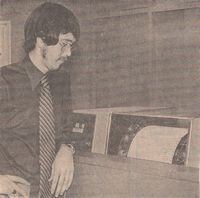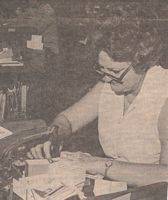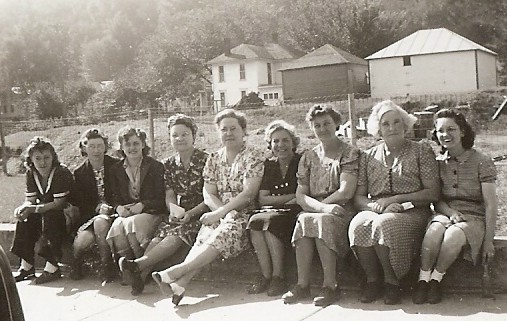page updated 03/03/2014
![]()
page updated 03/03/2014
Lansing Button Factory newspaper article & photos |
Button Boom at Lansing
By Art Hough, Cedar Rapids Gazette

Lansing Company moved to spacious new
quarters at the west edge of Lansing two years ago.
This is a front view of the administrative section. The
plant covers 90,000 square feet.
The Lansing Company was founded 75 years ago on tons of clams dug
from the Mississippi river bottom to make pearl buttons which
were worn the world over.
Now, the same company, still in the same family, is one of the largest button distributors in the United States -- an almost completely computerized operation, which makes no pearl buttons, in fact, makes no buttons at all.
But, it cards and distributes buttons by the millions.
According to John Brophy, president of the company since the 1950s, his great uncle, J.M. Turner, started a pearl button factory in this far northeast Iowa riverfront town in 1897.
Turner, an old river steamboat man, ran the factory for several years, after which his nephew, a man by the name of Hufschmidt, took over and operated the concern until his death in 1954.
Brophy had moved up to sales manager before he was elevated to
president in 1954.
 |
John Brophy (pictured at left) is president of the Lansing Company, founded on the Mississippi riverfront at Lansing by his great-uncle, J.M. Turner, in 1897. The concern is one of the largest distributors of buttons and zippers in the United States. |
More Than 200 Employees
Brophy recalled that when he joined the company in 1932, "I think we had 10 or 12 employees."
The Lansing Company now has more than 200 employees in its spacious, two-year-old plant, plus over 30 salesmen. The new complex is located in an industrial park as far back from the river as you can get and still stay in Lansing. The plant covers 90,000 square feet.
The Lansing Company stopped manufacturing buttons from clams as far back as 1926, Brophy says, and went out and bought glass buttons from Czechoslovakia, bakelite buttons domestically, etc.
"Buttons, through the years, have become more of a high fashion item to the point they have become almost comparable to pieces of jewelry, in many ways," Brophy said, "which has resulted in our going to the import field in the last 20 years -- importing from Holland, Italy, France, Japan ... "
Brophy said the more expensive buttons are from Holland and Italy, while Japan does a good job on so-called "staples."
Since there was still quite a market for Mississippi river clams in Japan as recent as three years ago, we asked why the manufacture of Lansing pearl buttons was dropped.
"Back when we were in the pearl button business," Brophy explained, "the clammer got $10 a ton for river run clams. When Japan was buying, as recently as three or four years ago, they were getting $80 and $100 a ton."
Brophy asserted, however, that the Japanese were buying only certain types of clams, which were shipped to Japan, ground, and the fragments placed in oysters to raise pearls.
All They Did, All Their Lives
"We had a factory that pretty much was run by old men. It was all they did, all of their lives. It was a matter of their own efforts how much they wanted to make.
"I'm taking you back to when it was about $14 or $15 a week.
"Frankly," Brophy confided, "the wage-hour bill was the thing that defeated it (the pearl button business) and the oncoming of polyester and acrylics and things like that.
"The buttons you have on your shirt right there are polyester and they're much better than a pearl button -- and a lot less money."
Perhaps like the fellow who wears suspenders with a belt, in 1966, the Lansing Company expanded its button distribution to include the zipper business.
"We missionaried the so-called bulk zipper -- a fine quality zipper, both in metal and nylon, which sells for under half what the package zipper does."
Lansing buttons and zippers are all sold through retail stores.
An IBM system helps keep track of more than 6,000 styles of buttons sold under "Lansing", "Majesty", "La Petite" and "Boutique" labels, as well as 700 types of "Quik" zippers.
Lansing is one of the first in the button industry to use computers for inventory control, all of its billing, payroll, practically everything.
The computers enable Lansing to project lead times from suppliers around the world and to process 100,000 Invoices a year from about 18,000 accounts.
Change of Styles
Through the computers Lansing is constantly programming new concepts and keeping track of each style of button already in inventory.
As Brophy notes, "It is priceless as far as style ends are concerned. If you get a 'dog' in the pile it looms up right away."
There is a terrific change in styles in the button industry. The computer says when to drop and and/or step up the distribution of another.
In round figures, Lansing computers are keeping tabs on 400 million buttons and 40 million zippers it ships annually.
Lansing went to computers in 1961. In December, 1973, when its new IBM System/370 is scheduled for delivery, the computer will give 200 million characters of information on line at one time.
~~~~~~~
 |
 |
 |
|
|
|
- source- Cedar Rapids Gazette, Cedar
Rapids, Iowa, 19 November 1972
- contributed by Errin Wilker
~*~*~*~*~*~*~

Lansing Button Company, undated
~photo contributed by Errin Wilker from her
personal collection
 Lansing Company workers undated photo |
|